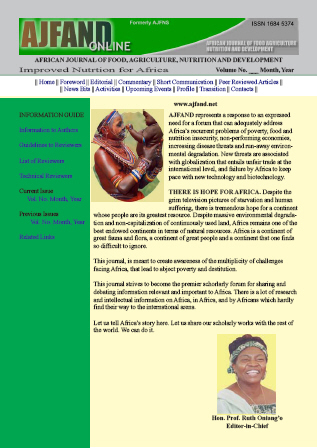
|
African Journal of Food, Agriculture, Nutrition and Development
Rural Outreach Program
ISSN: 1684-5358
EISSN: 1684-5358
Vol. 14, No. 1, 2014, pp. 8518-8528
|
 Bioline Code: nd14007
Bioline Code: nd14007
Full paper language: English
Document type: Research Article
Document available free of charge
|
|
|
African Journal of Food, Agriculture, Nutrition and Development, Vol. 14, No. 1, 2014, pp. 8518-8528
| en |
CONSUMPTION OF LEAFY VEGETABLES IN RURAL HOUSEHOLDS IN IJEBU-IGBO, OGUN STATE, NIGERIA
Adeyanju, A
Abstract
Problem of low consumption of vegetables by all in order to alleviate nutrition-related
diseases is still unresolved. This study investigated the pattern of consumption of
leafy vegetables among the inhabitants of Ijebu-Igbo enclave in Ogun State, Nigeria.
The instrument of data collection was interview schedule used to collect information
from 175 respondents sampled through simple random sampling technique from five
quarters in the locality. The head of the household was interviewed and question items
ranged from socio-economic characteristics of respondents to handling of and type of
leafy vegetables consumed, and awareness of the importance of consumption of these
vegetables. Consumption of leafy vegetables which was the dependent variable was
measured on an eight point scale. Both descriptive and inferential statistics were used
to analyze the data. The descriptive statistics involved frequency tallies, percentages
and averages while the inferential statistics used was chi-square analysis ( X2). The
results showed that most (74.9%) of the respondents were literate, having secondary
education and above, mostly (69.1%) females, married (56%) and predominantly
Christians (74. 3%). They were mostly (37%) traders and (22%) farmers. The level of
vegetable consumption was low, an average of 1.57 times weekly in the study area
with ‘Ugwu’ being most preferred over other vegetables which were celosia,
waterleaf, amaranthus and okra leaf. Only 35.4% of the respondents consumed
vegetables adequately but not properly handled or prepared. This is only 31.4% of the
recommended intake of 5 times daily. Only 9.1% of them adopted the most
appropriate method of preparation and handling of vegetables for maximum
absorption of nutrients but the closest method to the recommended method was
adopted by most (42%). The results of the hypotheses testing at 95% confidence level
showed a significant relationship between marital status (x2=0.26), religion (x2=0.94),
awareness level (x2=0.96) and consumption level. The study, therefore, recommended
a more strategic awareness-raising campaign and nutrition education to agricultural
extension and rural development agencies in order to influence people’s behaviour in
making vegetables consumption a lifestyle in the study area.
Keywords
consumption; leafy vegetable; rural household
|
| |
© African Journal of Food, Agriculture, Nutrition and Development
Alternative site location: http://www.ajfand.net/
|
|
